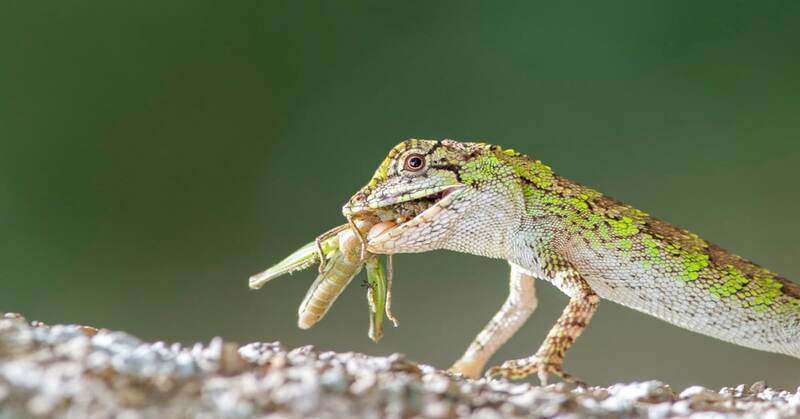Lizards are among the most diverse and numerous animals in rainforests across the world. With over 10,000 species, these reptiles have adapted to a variety of ecological niches to survive in the hot, humid rainforest environment.
But what do lizards eat in the rainforest to sustain themselves in such a biodiverse yet competitive ecosystem?

If you're short on time, here’s a quick overview: Most rainforest lizards are insectivores, feeding primarily on ants, termites, beetles, and other small invertebrates. Larger lizard species may also prey on small vertebrates like frogs, birds, eggs, and even smaller lizards.
| Dietary Category | Common Food Sources | Examples of Lizards That Consume This |
|---|---|---|
| Insects and Arthropods | Ants, termites, beetles, spiders | Tokay geckos, anoles |
| Small Vertebrates | Frogs, birds, eggs, small mammals | Tegus, green iguanas, monitor lizards |
| Fruits and Nectar | Figs, berries, guavas, bromeliad nectar | Arboreal lizards like chameleons |
| Carrion (Dead Animals) | Decaying animal remains | Monitor lizards, Komodo dragons |
Let’s take a deeper look into the types of food that rainforest lizards consume.
Rainforests are home to an estimated 30 million species of insects, making them a buffet for lizards. Most rainforest lizards rely heavily on these small, protein-rich creatures.
Ants are a staple in the diet of many lizards due to their abundance and easy accessibility.
Certain lizards, like the Tokay gecko, have adapted specialized sticky toe pads that allow them to cling to surfaces while hunting ants.
Some lizards raid ant nests to feast on both worker ants and their larvae.
Termites offer soft bodies packed with nutrients and are often found in large colonies.
Species like the Armored Ground Gecko have been observed breaking into termite mounds to consume large quantities of termites.
Termite mounds provide a concentrated source of food that requires less energy to hunt.
With over 400,000 beetle species, these hard-shelled insects are an essential food source for many rainforest lizards.
Smaller beetles can be swallowed whole after being crushed, while larger beetles may need to be torn apart using the lizard's teeth.
The hard exoskeleton provides calcium, supporting bone strength.
Lizards also prey on spiders, caterpillars, worms, snails, and slugs.
Some larger lizards have even been observed eating scorpions and centipedes, carefully avoiding their pincers or stingers.
Geckos are especially adept at hunting a variety of small arthropods, including flies and moths.
Larger rainforest lizards often include small vertebrates in their diet to meet their nutritional needs.
| Prey Type | Description | Examples |
|---|---|---|
| Frogs and Toads | Many lizards consume tree frogs and dart frogs. Some larger species, like green iguanas, may even eat giant marine toads. | Green iguanas, tegus |
| Small Mammals | Bats, shrews, and rodents are occasionally hunted by larger lizards like tegus. | Tegus, monitor lizards |
| Birds and Eggs | Arboreal lizards like chameleons may snatch eggs from nests. The Jesus Christ lizard has even been seen eating hatchlings. | Chameleons, Jesus Christ lizards |
In addition to hunting live prey, some rainforest lizards also consume fruits and nectar to supplement their diet.
Rainforests are full of fruit-bearing plants, and lizards take advantage of the bounty.
| Fruit Type | Description | Examples of Fruit-Eating Lizards |
|---|---|---|
| Figs | Ripe figs that fall to the forest floor are devoured by lizards like anoles. | Anoles, green iguanas |
| Berries | Shrubs bearing soft fruits like raspberries and blackberries attract lizards. | Chameleons, skinks |
| Bananas | Wild bananas provide starch and sugar for energy. | Iguanas, arboreal geckos |
| Guavas | Ground-dwelling lizards readily eat ripe guavas. | Tegus, green iguanas |
Nectar provides lizards with a sugary energy boost. Common nectar sources include:
Bromeliads: Epiphytic plants that grow on trees produce nectar that attracts skinks and chameleons.
Orchids: Many orchids provide lizards with floral nectar, which also makes them inadvertent pollinators.
Passion Vines: Passionflower nectar is a gourmet treat for nectar-feeding lizards.
While live prey makes up the majority of a lizard’s diet, some rainforest lizards, especially large species, will feed on carrion when available.
| Key Points | Details |
|---|---|
| Abundance of Carrion | Dead animals decompose quickly in rainforests, providing lizards with occasional scavenging opportunities. |
| Scavenger Lizards | Monitor lizards and tegus are especially skilled at detecting carcasses from a distance using their keen sense of smell. |
| Examples of Carrion | Pigs, deer, and even smaller reptiles can become carrion for lizards. |
Feeding on carrion provides lizards with an easy source of protein without the need to expend energy hunting. However, carrion consumption carries risks like exposure to bacteria and parasites.
| Lizard Species | Carrion Preference |
|---|---|
| Komodo Dragon | Feeds on large carcasses like deer and buffalo |
| Perentie Monitor | Scavenges kangaroo carcasses |
| Green Iguanas | Mostly herbivorous but will scavenge opportunistically |
Rainforest lizards play a crucial role in their ecosystems by occupying a wide variety of dietary niches. Most species are primarily insectivores, thriving on the abundant supply of ants, termites, and beetles. However, some larger lizards have adapted to consume small vertebrates, fruits, nectar, and even carrion.
Understanding what lizards eat in the rainforest provides fascinating insight into how these reptiles survive and thrive in the lush, biodiverse environments of tropical forests worldwide. Their varied diets highlight the adaptability and resilience of lizards in one of the most complex ecosystems on Earth.
animal tags: lizards
We created this article in conjunction with AI technology, then made sure it was fact-checked and edited by a Animals Top editor.